Introduction
Capital markets are evolving rapidly as artificial intelligence (AI) becomes embedded in core operations—from high-frequency trading to risk modeling and compliance automation. AI’s ability to analyze vast datasets and make split-second decisions is redefining how financial institutions manage complexity, mitigate risk, and seize market opportunities.
As firms seek speed, precision, and smarter insights, AI is emerging as a critical differentiator. This guide explores key AI use cases transforming capital markets and how early adopters are gaining a decisive competitive edge.
What is AI and Why Does It Matter in Capital Markets?
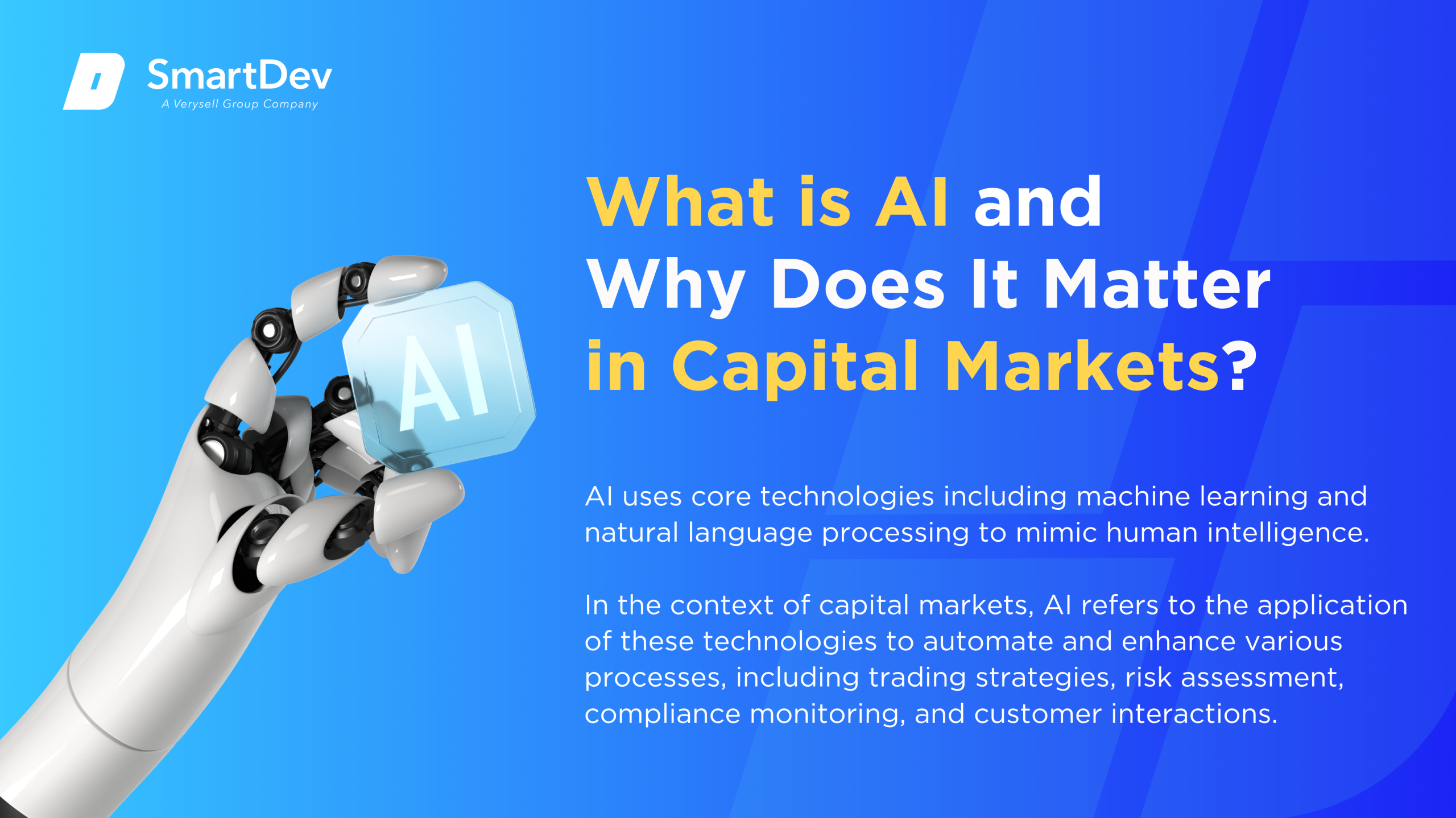
Definition of AI and Its Core Technologies
Artificial Intelligence (AI) encompasses computer systems designed to perform tasks that typically require human intelligence, such as learning, reasoning, problem-solving, and decision-making. Key technologies under the AI umbrella include machine learning (ML), natural language processing (NLP), and computer vision.
In the context of capital markets, AI refers to the application of these technologies to automate and enhance various processes, including trading strategies, risk assessment, compliance monitoring, and customer interactions. By leveraging AI, financial institutions can process vast amounts of data at unprecedented speeds, uncover hidden patterns, and make more informed decisions.
The Growing Role of AI in Transforming Capital Markets
AI is increasingly central to the evolution of capital markets, driving innovation and operational efficiency. For instance, AI-powered algorithms enable high-frequency trading firms to execute trades in milliseconds, capitalizing on market opportunities faster than human traders.
Beyond trading, AI enhances risk management by analyzing complex datasets to predict potential market disruptions, allowing firms to proactively mitigate risks. Additionally, AI streamlines compliance processes by automatically monitoring transactions and communications for regulatory breaches, reducing the likelihood of costly penalties.
Moreover, AI-driven tools assist in customer engagement by providing personalized investment recommendations and real-time support, thereby improving client satisfaction and loyalty.
Key Statistics and Trends Highlighting AI Adoption in Capital Markets
The adoption of AI in capital markets is accelerating. According to a McKinsey Global Survey, 85% of financial services firms have implemented AI in at least one business function, with many planning to expand its use.
Furthermore, the generative AI market in banking and finance is projected to grow from $1.29 billion in 2024 to $21.57 billion by 2034, driven by AI adoption, digital transformation, and data security.These trends underscore the critical role AI plays in enhancing competitiveness and driving growth within capital markets.
Business Benefits of AI in Capital Markets
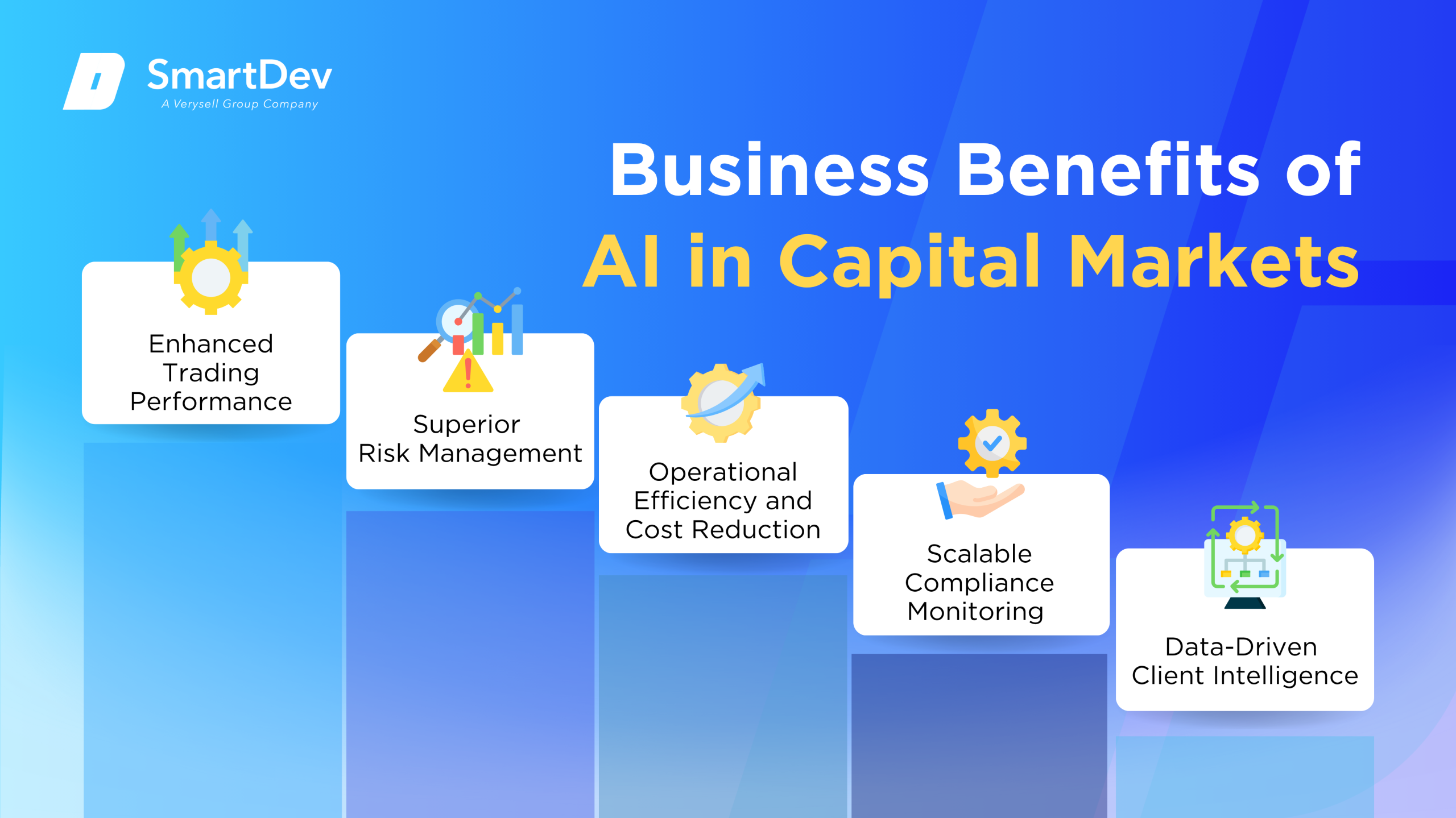
1. Enhanced Trading Performance
AI enables trading systems to interpret market signals, assess volatility, and execute strategies far beyond human speed or accuracy. This capability allows firms to exploit short-term price inefficiencies and dynamically adapt to changing market conditions. Over time, this not only improves trade execution but also enhances alpha generation.
By continuously learning from historical and real-time data, AI models reduce reliance on static trading rules. They help build more resilient portfolios that can adjust to market shifts, contributing to stronger performance and lower trading costs.
Dive into our case study on building a high-performance fintech trading platform to see how we help the platform balances real-time execution, scalability, and cost-efficiency under tight budget constraints.
2. Superior Risk Management
Risk management in capital markets involves assessing exposure across portfolios, counterparties, and systemic events. AI improves this process by uncovering non-obvious correlations and stress-testing portfolios against a broader range of scenarios.
Machine learning models allow risk teams to move beyond traditional value-at-risk metrics and instead incorporate real-time market data, behavioral patterns, and sentiment analysis. This leads to more proactive and comprehensive risk oversight.
Dive into our article on AI credit evaluation to see how intelligent risk modeling is helping financial firms mitigate default risks and make more accurate credit decisions.
3. Operational Efficiency and Cost Reduction
Manual processes—like transaction matching, data reconciliation, and report generation—consume vast operational resources. AI automates these tasks with high accuracy, reducing the need for human intervention and lowering error rates.
This automation shortens cycle times and frees up skilled staff to focus on higher-value analytical work. The result is not just cost savings but a more agile and scalable operating model.
To see how predictive maintenance enhances efficiency in real-world operations, our guide on how AI is rewriting the rules of manufacturing shows what’s possible.
4. Scalable Compliance Monitoring
Regulatory environments demand consistent monitoring of trades, communications, and internal processes. AI enables real-time surveillance by scanning large volumes of structured and unstructured data to flag potential violations.
This shift from reactive audits to continuous monitoring reduces the risk of non-compliance and supports transparency. It also allows compliance teams to operate more effectively at scale without proportional increases in headcount.
5. Data-Driven Client Intelligence
Capital markets firms manage diverse client relationships—from institutional investors to retail traders. AI helps interpret behavioral, transactional, and demographic data to deliver more personalized services and insights.
This enhances client engagement and retention by aligning product offerings and communication strategies with individual client needs. Over time, it builds trust and loyalty, supporting long-term growth.
Challenges Facing AI Adoption in Capital Markets
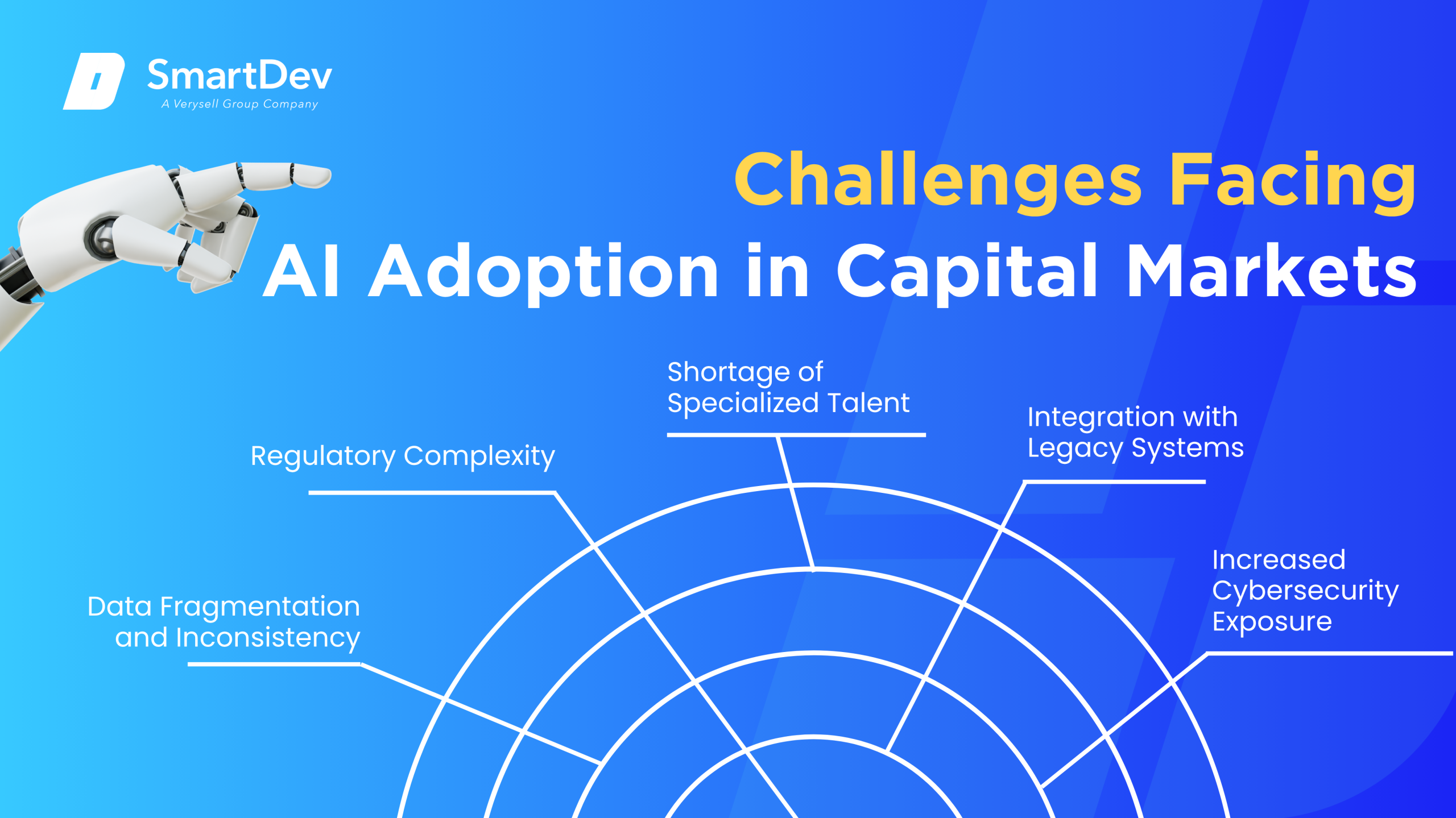
1. Data Fragmentation and Inconsistency
AI relies on clean, integrated data to deliver accurate outputs. However, financial institutions often operate with siloed systems and inconsistent data formats, making it difficult to consolidate information for modeling and analysis.
Without a strong data governance framework, AI solutions are limited in their ability to detect patterns or deliver actionable insights. Poor-quality data leads to weak predictions and erodes stakeholder confidence in automation tools.
2. Regulatory Complexity
AI introduces opacity into decision-making, especially in high-stakes financial applications. Regulators are increasingly scrutinizing AI models for explainability, fairness, and accountability.
Institutions must ensure their models meet emerging compliance standards, such as explainable AI (XAI) requirements, which often require rethinking how models are designed, validated, and audited. This creates a layer of regulatory risk that demands careful management.
For strategies on navigating AI regulations while maintaining trust and transparency, our detailed guide on AI and data privacy offers actionable insights.
3. Shortage of Specialized Talent
The intersection of finance and advanced AI requires highly specialized skills in data science, quantitative finance, and software engineering. This talent is scarce and in high demand.
Without in-house expertise, firms risk deploying black-box solutions they cannot fully understand or optimize. Building or acquiring this talent is essential for sustaining AI initiatives and ensuring their alignment with business objectives.
4. Integration with Legacy Systems
Many capital markets firms operate on legacy infrastructure that wasn’t built for real-time data processing or machine learning. Integrating modern AI tools with outdated systems is technically complex and costly.
This slows implementation timelines and often requires custom middleware or parallel system builds. Overcoming this challenge demands strategic investment in IT modernization and long-term infrastructure planning.
5. Increased Cybersecurity Exposure
AI systems process sensitive financial and client data, making them attractive targets for cyberattacks. Additionally, adversarial inputs can be used to manipulate AI algorithms in subtle and damaging ways.
Protecting AI models from both data theft and algorithmic manipulation requires continuous threat monitoring and advanced cybersecurity protocols. Failure to secure these systems can compromise both operational integrity and client trust.
Specific Applications of AI in Capital Markets
Artificial Intelligence (AI) is revolutionizing capital markets by reshaping how trading, risk management, compliance, and customer engagement are conducted. From algorithmic execution to regulatory monitoring, AI is driving significant improvements in speed, efficiency, and insight.
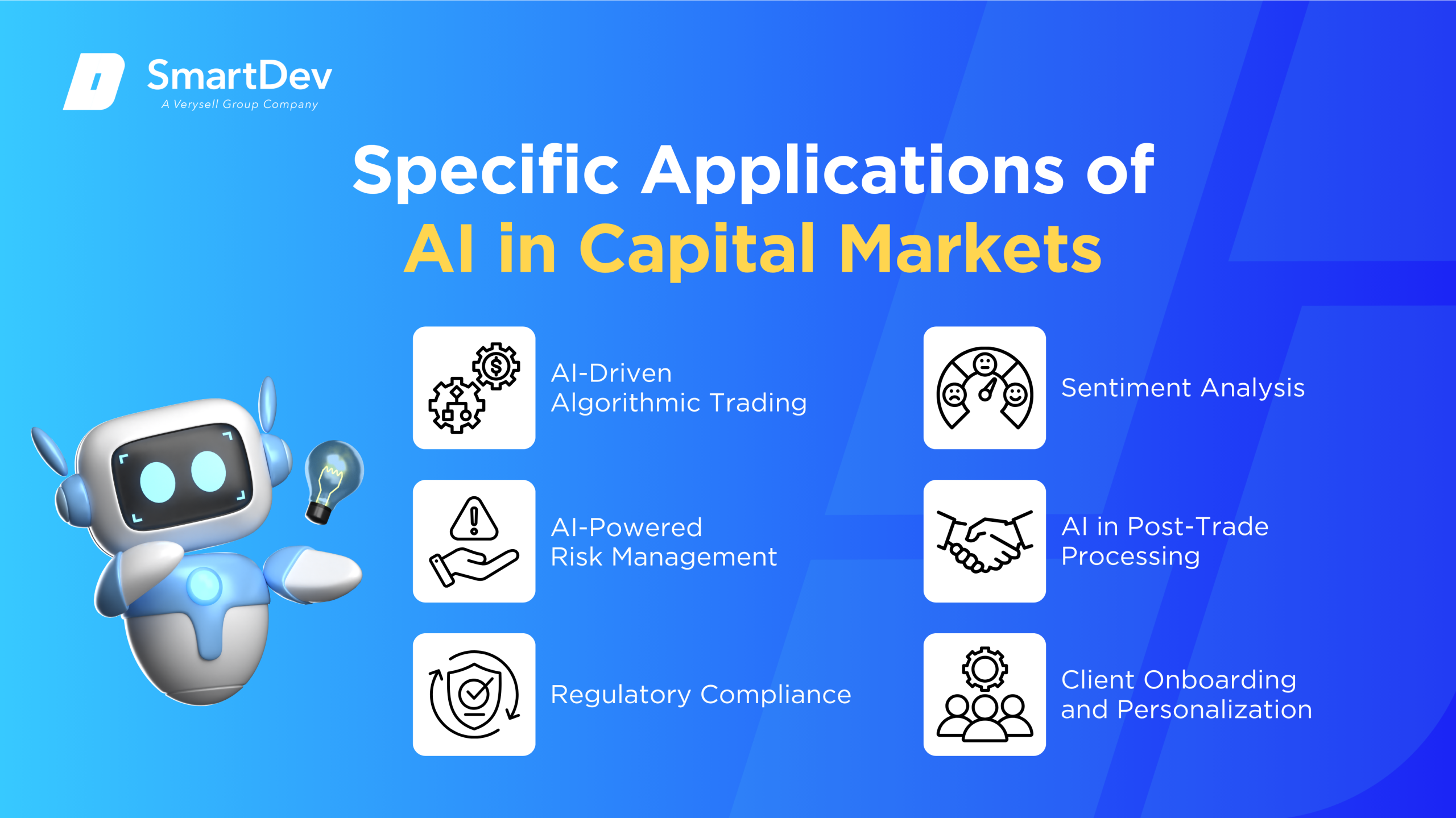
1. AI-Driven Algorithmic Trading
AI-powered algorithmic trading enables capital market participants to execute trades with speed and precision far beyond human capability. By analyzing massive datasets including historical prices, market trends, and real-time news, AI models can predict price movements and optimize trade execution. This approach enhances market responsiveness and minimizes slippage in fast-moving environments.
Behind the scenes, techniques such as deep learning and reinforcement learning are deployed to identify patterns and optimize trading strategies. These models continuously ingest new data, adjusting predictions and decisions accordingly. Seamless integration into trading systems ensures real-time execution aligned with market dynamics.
The strategic value lies in improved profitability, reduced operational costs, and enhanced trade accuracy. AI also supports 24/7 market engagement and lowers the likelihood of human error. However, risks remain in model transparency, overfitting, and compliance with market regulations.
Real-World Example:
AQR Capital Management, a $136 billion hedge fund, transitioned to AI-driven trading by allowing data to guide investment decisions. Leveraging machine learning, its Apex and Delphi funds delivered annualized net returns of 19% and 14.6%, respectively, underscoring the performance potential of AI-integrated strategies.
2. AI-Powered Risk Management
AI is transforming risk management by providing more precise, real-time insight into market, credit, and operational risks. These systems can predict future risks, simulate stress scenarios, and recommend mitigation strategies before issues escalate. As volatility becomes more frequent, proactive risk intelligence is vital for capital markets firms.
Machine learning models such as reinforcement learning-based Value-at-Risk (VaR) estimators and volatility forecasting models assess risk exposures dynamically. They draw on structured and unstructured data sources—including transaction history, macroeconomic indicators, and market signals—to create comprehensive risk profiles. Integration with internal platforms allows for automated risk scoring and alert generation.
Strategically, AI enhances capital efficiency and supports more accurate regulatory reporting. It reduces manual intervention, speeds up risk assessments, and ensures consistency across portfolios. Data governance and explainability are key challenges, especially when dealing with black-box models.
Real-World Example:
Germany’s financial regulator, BaFin, has begun utilizing AI to enhance its ability to detect market abuse and identify suspicious trading patterns. The integration of AI into the agency’s alert and market analysis system has improved the accuracy of findings, increasing the likelihood of catching offenders. This advancement significantly boosts the effectiveness of market surveillance.
3. Regulatory Compliance
AI helps financial institutions meet complex compliance obligations by automating monitoring, documentation, and reporting. Natural Language Processing (NLP) tools can scan regulatory updates, internal policies, and communications to ensure adherence and flag potential violations. This proactive compliance monitoring reduces risk and keeps firms audit-ready.
These systems analyze emails, voice recordings, trading logs, and regulatory texts. Machine learning algorithms identify suspicious behaviors, correlate them with transaction data, and generate risk-based alerts. When integrated with compliance management platforms, they provide end-to-end transparency and traceability.
For firms, this translates into fewer regulatory breaches, lower compliance costs, and faster response times. It also improves operational efficiency and scales easily across global operations. However, ensuring privacy and minimizing false positives are ongoing concerns.
Real-World Example:
Asset management firm Schroders uses its proprietary AI tool, Genie, to analyze central bank communications and internal data. This enables both regulatory compliance and sharper macroeconomic forecasting for fixed income investments. The tool has become integral to their investment strategy development.
4. Sentiment Analysis
AI-based sentiment analysis tools capture market mood by processing news headlines, social media posts, and analyst reports. These insights help traders and portfolio managers anticipate investor behavior and adjust positions accordingly. In volatile markets, understanding sentiment trends is a key competitive advantage.
Using NLP, AI systems categorize text as positive, negative, or neutral while detecting context-specific tones. They scan vast unstructured datasets in real time, flagging key events and generating sentiment scores that influence trading decisions. Integration with dashboards and trading algorithms ensures actionable insights.
This enhances agility and precision in investment strategies, especially during major events like earnings calls or policy announcements. However, the accuracy of these models depends on linguistic nuance and training data quality. Misinterpretation or bias in textual sources can affect outcomes.
Real-World Example:
Researchers at Yale analyzed 1.1 million analyst notes using AI and found that the narrative content of reports held greater investment value than numeric forecasts alone. Their analysis outperformed standard models based on price targets.
5. AI in Post-Trade Processing
Post-trade operations benefit from AI by automating reconciliation, settlement, and clearing. These processes, which traditionally involve manual matching and error-checking, are now managed more efficiently through AI. This leads to faster transaction settlements and reduced operational risk.
AI identifies mismatches, missing fields, or anomalies in trade data using pattern recognition algorithms. Machine learning improves over time by learning from past exceptions and resolutions. When embedded into back-office systems, these tools allow for near real-time reconciliation across multiple asset classes.
Firms experience cost savings, faster trade finality, and enhanced client satisfaction. Automation also supports regulatory compliance and auditability. However, integration across legacy systems and standardization of data formats are common obstacles.
Real-World Example:
Deloitte highlights that AI supports post-trade processing by automating risk management, compliance checks, and data reconciliation, significantly reducing operational costs in capital markets. The implementation of AI in these areas has streamlined processes and improved efficiency. This advancement is pivotal in modernizing post-trade operations.
6. Client Onboarding and Personalization
Client onboarding in capital markets is complex, often requiring KYC checks, risk profiling, and documentation. AI simplifies this by automating identity verification, data extraction, and compliance checks. The result is a faster and more accurate onboarding experience.
AI tools process client-submitted documents using OCR and NLP to extract relevant information. Machine learning algorithms then assess risk, determine client preferences, and recommend tailored products or services. Integration with CRM systems enhances personalization and long-term relationship management.
This boosts acquisition speed and improves client satisfaction while maintaining regulatory compliance. Personalized experiences also lead to better client retention and deeper engagement. Privacy and data protection remain top concerns in implementation.
Real-World Example:
Google Cloud reports that generative AI tools help financial advisors quickly understand client goals and needs, significantly reducing onboarding time and enhancing personalization. These tools process vast amounts of data to provide tailored recommendations, improving client engagement. This innovation marks a significant step forward in client relationship management.
Examples of AI in Capital Markets
Real-World Case Studies
Building upon the specific applications discussed, real-world implementations of AI in capital markets demonstrate its transformative impact. The following case studies illustrate successful AI integration across various functions.

1. Goldman Sachs: Scaling AI Across Global Operations
Goldman Sachs is rapidly scaling its use of AI across global operations, aiming for full integration within three years. Led by CIO Marco Argenti, the firm has already rolled out AI tools to 10,000 employees, with plans to expand firmwide by year-end. These tools, built on Goldman’s proprietary GS AI Platform, are designed to boost productivity while ensuring data security.
Among the tools are GS AI Assistant, a ChatGPT-style interface for internal data; Banker Copilot for drafting and filings; and Legend AI Query for natural language database searches. Others like Translate AI and Legend Copilot enhance global communication and backend operations. These applications have shown up to 20% efficiency gains and are seen as transformative by the firm’s leadership.
2. JPMorgan Chase: Enhancing Client Engagement with AI
JPMorgan has transformed trading operations with LOXM, an AI platform that optimizes trade execution across global equity markets. It processes market data in real time, predicts price movements, and executes trades to reduce costs and market impact. This technology underscores how AI boosts precision and responsiveness in high-stakes trading.
Beyond trading, JPMorgan uses AI to handle client requests and deliver investment advice at scale. These tools enabled a 20% sales increase from 2023 to 2024, especially during turbulent markets. Looking ahead, the bank expects a 50% increase in its client base within five years due to AI adoption.
3. BlackRock: Integrating AI into Investment Strategies
BlackRock is leveraging advanced AI to reshape how investments are managed, viewing AI as a long-term strategic shift. Its AI Labs unite researchers, data scientists, and financial experts to tackle complex investment challenges. The firm sees AI as critical to remaining competitive in a data-driven industry.
The Aladdin platform is central to this strategy, using AI to evaluate markets, forecast risks, and optimize portfolios. Trusted by global institutions and regulators, Aladdin’s capabilities were even utilized by the US Fed during past crises. This positions BlackRock as a frontrunner in AI-led investment management.
Innovative AI Solutions
Emerging AI technologies are revolutionizing capital markets by driving new levels of automation, insight, and efficiency. These innovations are not only enhancing operational workflows but also fundamentally reshaping strategic decision-making. As firms race to adopt advanced tools, the competitive edge is shifting toward those that can harness AI effectively across their business functions.
Generative AI is now playing a crucial role in investment research and financial analysis. Tools like FinRobot and other large language model-based platforms help analysts process vast datasets, interpret financial reports, and generate valuation models. By combining qualitative insights with quantitative data, these systems emulate the analytical depth of experienced professionals—at scale and in real time.
Another breakthrough area is autonomous AI agents, which assist in everything from portfolio optimization to automated regulatory reporting. These agents continuously learn and adapt based on evolving market conditions and compliance requirements. As these tools mature, they are expected to further reduce manual workload, enhance accuracy, and open new possibilities for real-time financial strategy execution.
Dive into our guide on how to create an AI agent to understand the architecture behind the intelligent systems now shaping capital market operations.
AI-Driven Innovations Transforming Capital Markets
Emerging Technologies in AI for Capital Markets
AI is transforming capital markets by streamlining how financial data is analyzed and acted upon. Generative AI now reads and interprets complex reports like earnings filings and regulatory disclosures, delivering fast, accurate insights for investment decisions. This allows analysts to focus more on strategy and less on sifting through mountains of text.
Meanwhile, computer vision is opening up new ways to evaluate the market. By analyzing satellite images and other visual data, firms can track real-world trends – like retail traffic or factory activity – and turn them into valuable trading signals. It’s a whole new layer of market intelligence that didn’t exist before.
AI’s Role in Sustainability Efforts
AI is becoming a vital tool for advancing sustainability in capital markets. Predictive models help investors evaluate ESG performance by projecting the long-term environmental and social impact of assets. This leads to smarter, values-driven investment strategies that align with evolving regulatory and stakeholder expectations.
At the same time, AI is helping financial institutions reduce their own environmental footprint. Smart systems manage energy usage in data centers and trading operations, making day-to-day processes more efficient. And on a broader scale, AI models guide sustainable portfolio choices, helping firms lead the way in responsible investing.
How to Implement AI in Capital Markets
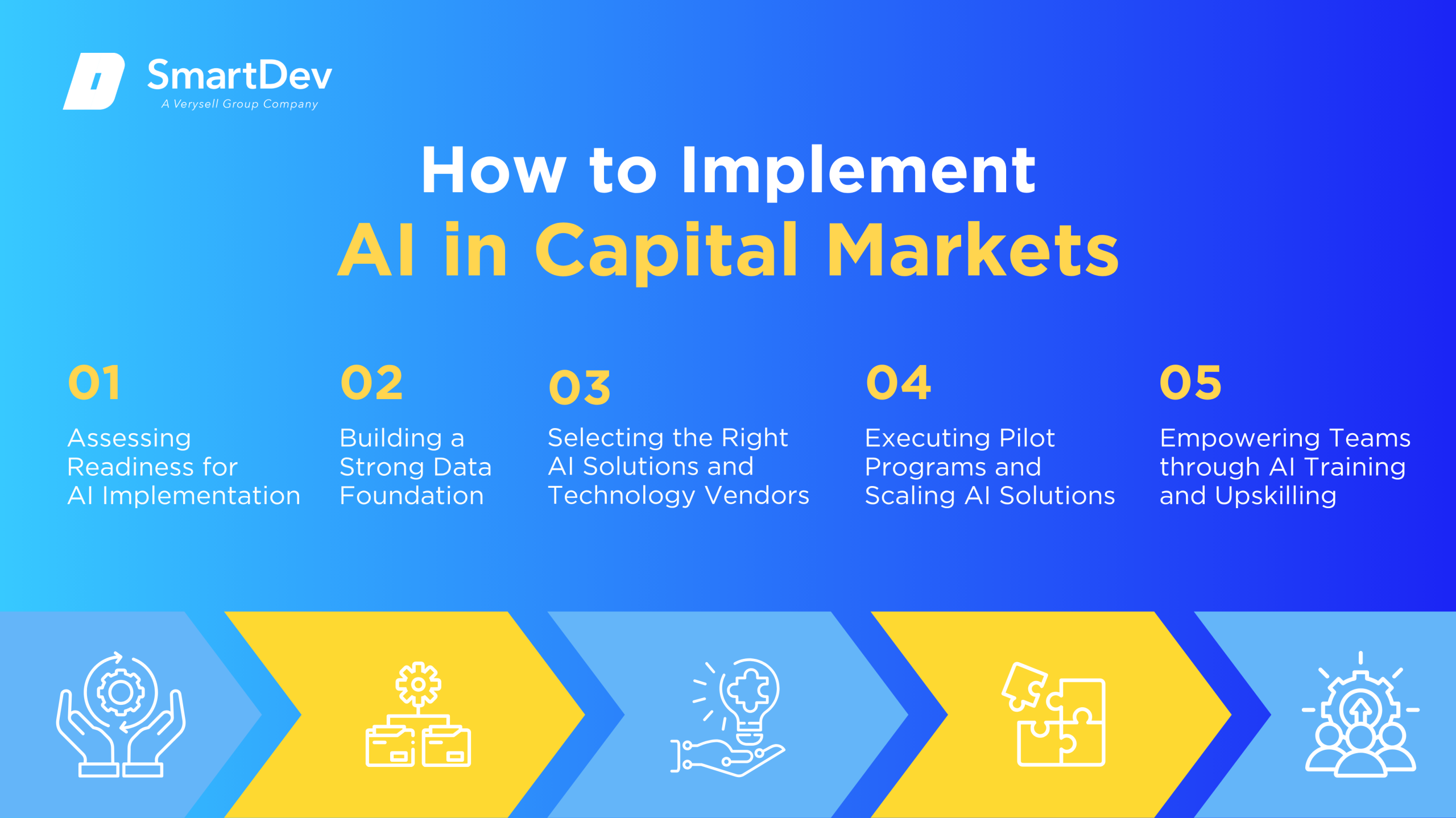
Step 1. Assessing Readiness for AI Adoption
Before integrating AI, firms must evaluate their current technological infrastructure and data management capabilities. Identifying areas where AI can add value, such as trading, compliance, or customer service, is essential. Engaging stakeholders across departments ensures a comprehensive understanding of AI’s potential impact.
Firms should also assess their organizational culture and readiness for change. Implementing AI requires a shift towards data-driven decision-making and continuous learning. Establishing clear objectives and success metrics will guide the adoption process and help measure outcomes.
Step 2. Building a Strong Data Foundation
A robust data infrastructure is critical for successful AI implementation. Firms must ensure data quality, consistency, and accessibility across systems. Implementing data governance frameworks and investing in data management tools will facilitate effective AI deployment.
Data privacy and security are paramount. Compliance with regulations such as GDPR and ensuring ethical data usage will build trust among stakeholders and customers. Regular audits and monitoring can help maintain data integrity and security.
Step 3. Choosing the Right Tools and Vendors
Selecting appropriate AI tools and vendors involves evaluating their capabilities, scalability, and alignment with business objectives. Firms should consider vendors with experience in capital markets and a track record of successful implementations. Open communication and collaboration with vendors will ensure solutions meet specific needs.
It’s also important to assess the interoperability of AI tools with existing systems. Choosing solutions that integrate seamlessly can reduce implementation time and costs. Pilot testing and feedback loops will help refine tool selection and customization.
Step 4. Pilot Testing and Scaling Up
Starting with pilot projects allows firms to test AI applications in controlled environments. These pilots can provide insights into performance, challenges, and potential improvements. Gathering feedback from users and stakeholders will inform adjustments and enhancements.
Once pilots demonstrate value, firms can scale up AI applications across departments. Developing a roadmap for expansion, including timelines, resource allocation, and training, will facilitate a smooth transition. Continuous monitoring and evaluation will ensure sustained success.
Step 5. Training Teams for Successful Implementation
Employee training is vital for effective AI integration. Providing education on AI concepts, tools, and applications will empower staff to leverage new technologies. Encouraging a culture of innovation and adaptability will support ongoing learning and development.
Cross-functional collaboration between technical and business teams can enhance understanding and utilization of AI. Regular workshops, seminars, and knowledge-sharing sessions will keep teams informed about advancements and best practices.
Measuring the ROI of AI in Capital Markets
Key Metrics to Track Success
Evaluating the return on investment (ROI) of AI initiatives involves tracking various metrics. Productivity improvements can be measured by increased efficiency in trading operations and reduced manual processes. Cost savings achieved through automation, such as decreased labor expenses and error rates, are also significant indicators.
Additionally, firms should monitor revenue growth attributed to AI-driven strategies, customer satisfaction levels, and compliance adherence. Analyzing these metrics over time will provide a comprehensive view of AI’s impact on business performance.
Case Studies Demonstrating ROI
AQR Capital Management, a prominent quantitative hedge fund, has embraced AI and machine learning to enhance trading decisions. By integrating AI into their investment strategies, AQR’s top-performing hedge funds, Apex and Delphi, achieved annualized net returns of 19% and 14.6%, respectively.
Similarly, Datasite, a dealmaking workflow automation company, acquired Grata, an AI-powered private markets intelligence firm, to enhance its technological capabilities. This acquisition aimed to improve deal sourcing and due diligence services, contributing to Datasite’s consistent annual earnings growth of around 20%.
Common Pitfalls and How to Avoid Them
Implementing AI in capital markets can present challenges. One common pitfall is underestimating the complexity of AI integration, leading to unrealistic expectations and project delays. To mitigate this, firms should conduct thorough planning and set achievable goals.
Another issue is inadequate data quality, which can compromise AI performance. Establishing robust data management practices and ensuring data integrity are essential. Additionally, resistance to change among employees can hinder adoption. Providing comprehensive training and fostering a culture of innovation will facilitate smoother transitions.
Future Trends of AI in Capital Markets
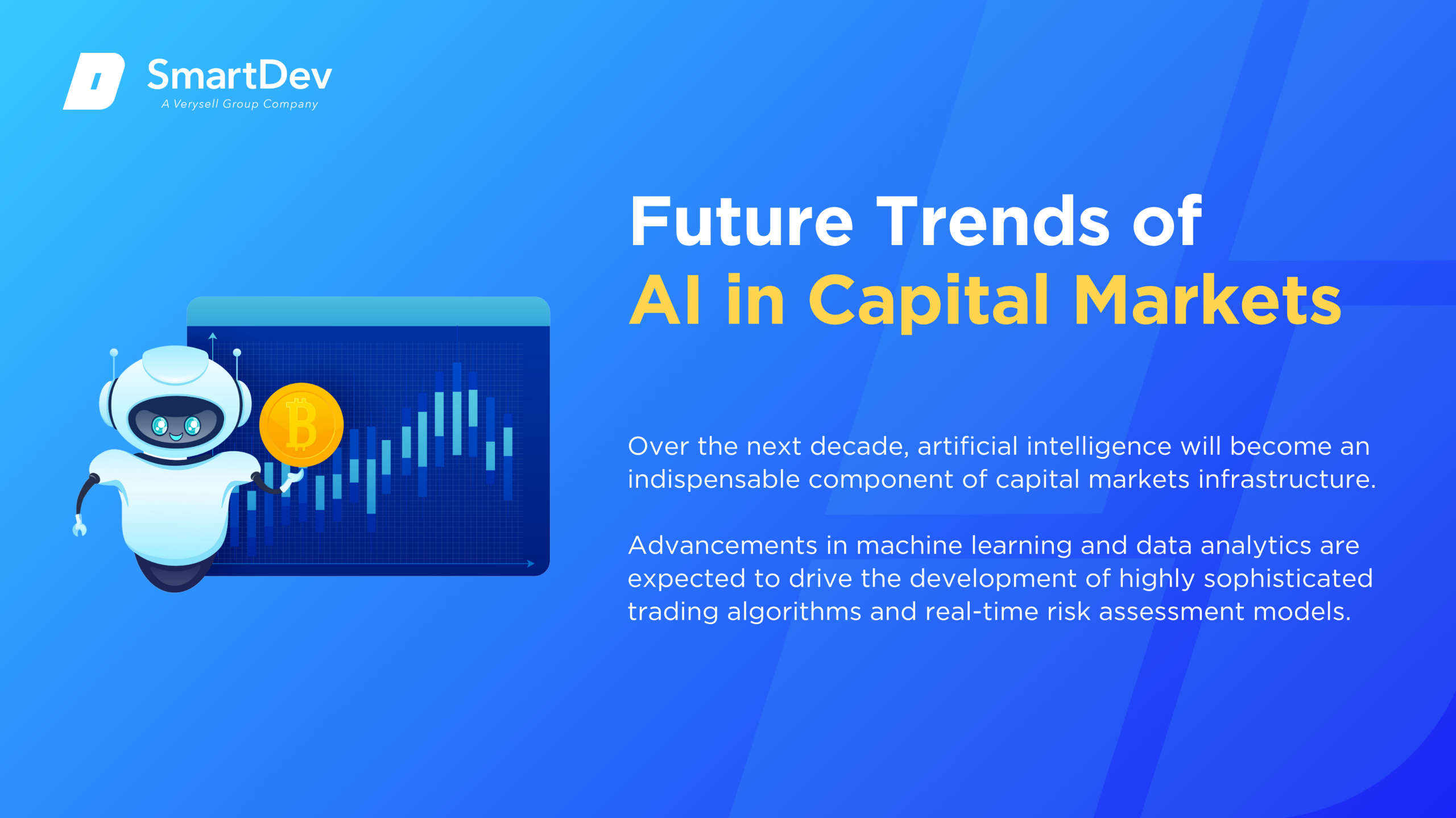
Predictions for the Next Decade
Over the next decade, artificial intelligence will become an indispensable component of capital markets infrastructure. Advancements in machine learning and data analytics are expected to drive the development of highly sophisticated trading algorithms and real-time risk assessment models. Simultaneously, AI will increasingly support regulatory compliance by automating monitoring, auditing, and reporting processes.
Moreover, the convergence of AI with emerging technologies such as blockchain and quantum computing will pave the way for significant innovation. This integration will enhance the transparency, security, and operational efficiency of financial transactions. As a result, firms that harness these synergies will gain a substantial competitive edge in a rapidly evolving digital landscape.
How Businesses Can Stay Ahead of the Curve
To remain competitive in an AI-driven market, financial institutions must make proactive investments in research, infrastructure, and strategic innovation. Engaging with technology partners and participating in industry consortia will enable access to emerging solutions and foster a forward-thinking approach. Keeping pace with regulatory developments and aligning AI strategies accordingly will ensure both compliance and long-term stability.
Equipping teams with the skills necessary to adopt and apply AI technologies is equally critical. Companies should implement continuous training programs and create opportunities for cross-functional collaboration. A culture that embraces innovation, adaptability, and knowledge sharing will be key to sustaining growth and driving future transformation.
Conclusion
Key Takeaways
AI is fundamentally transforming capital markets by streamlining operations, enhancing analytical capabilities, and enabling faster, data-driven decisions. From generative AI improving investment research to computer vision unlocking new forms of economic insight, these technologies are reshaping how firms compete. Their impact is evident across trading, compliance, risk management, and client services.
Moreover, AI is supporting the industry’s growing focus on sustainability by enabling ESG-aligned investing and operational efficiencies. Successful implementation depends on strong data infrastructure, thoughtful vendor selection, and ongoing workforce development. Firms that prioritize measurable outcomes and continuous adaptation will be best positioned to capture AI’s full strategic value.
Moving Forward: A Path to Progress
As AI continues to redefine the landscape of capital markets, investment firms, asset managers, and financial institutions have a pivotal opportunity to enhance performance, reduce risk, and drive data-informed innovation. From algorithmic trading and AI-powered compliance to predictive analytics and ESG intelligence, strategic AI integration is quickly becoming a cornerstone of competitive advantage.
At SmartDev, we design and deliver tailored AI solutions that empower capital markets players to operate more efficiently, gain deeper market insights, and respond faster to change. Whether it’s automating regulatory reporting or implementing AI models for advanced risk forecasting, our team works closely with yours to align intelligent technologies with your operational and strategic goals.
Contact us today to discover how AI can transform your financial operations, elevate decision-making, and keep your business ahead in an increasingly data-driven world.
—
References:
- The state of AI: How organizations are rewiring to capture value | McKinsey & Company
- Five non-trading cutting-edge use cases for AI in capital markets | N-iX
- German financial watchdog: AI is helping to catch market abuse | Reuters
- Artificial intelligence in capital markets: Leveraging AI to optimize post-trade processes | Deloitte
- 10 ways JP Morgan is using AI – Case Study [2025] | DigitalDefynd
- Can Large Language Models Beat Wall Street? Unveiling the Potential of AI in Stock Selection | arXiv
- Everything we know about how Wall Street is adopting AI, from Goldman Sachs to Point72 | Business Insider
- FinRobot: AI Agent for Equity Research and Valuation with Large Language Models | arXiv
- BEYOND THE HYPE: How AI will change capital markets and what organisations should do about it | Economist Impact







